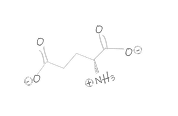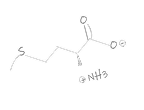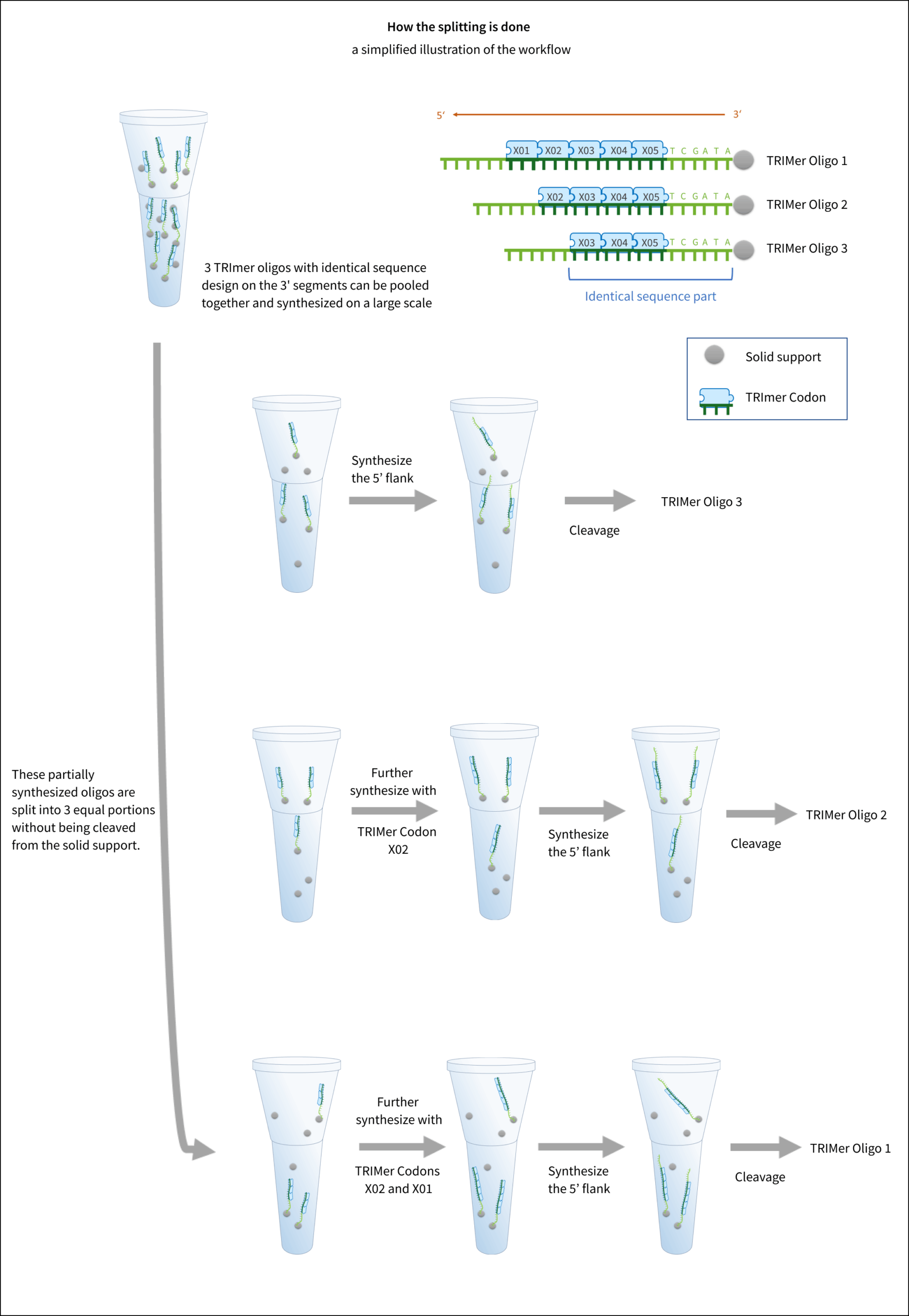








TRIM Technology –Maximize Efficiency and Precision in Library Constructions.
TRIM Technology
The use of 2′-deoxynucleoside TRIM phosphoramidites is a particularly efficient way to approach oligonucleotide-directed mutagenesis. Of the 64 possible combinations of codons, only 20 codons are required to cover the 20 amino acids.
In contrast to other methods of mutagenesis, libraries built from TRImer oligonucleotides do not lead to codon bias, do not produce stop codons, and allow custom mixing to control codon abundance, making them one of the most efficient tools for exploring sequence space in protein regions important for function – even under non-saturating conditions.
The reaction factor of each new TRImer-phosphoramidite batch is determined by Ella Biotech prior to use in synthesis. The reaction factor is critical as the TRImers are likely to be mixed and have different reactivities in the coupling reaction.
Length
We offer custom oligos using TRIM technology ranging from 50 to 120 nucleotides, with high fidelity synthesis and reliable performance. For different lengths or special requests, please inquire for tailored solutions.
Scales and Yields
Our main attention in TRImer oligonucleotides lies on low error rate during synthesis since any purification method used for increasing quality may simultaneously lead to loss of diversity. To decrease error rate, we use much higher stoichiometric excess than industry standard. For highest possible coupling efficiency we therefore only offer 40 nmol scale syntheses for TRImer oligos.
TRImer
Purification Method
Scale [nmol]
Minimum Yield in nmol – Based On Oligo Length [nt]
10
90
100
120
HPLC/PAGE
40
2
Please inquire
For detailed information please read Scale And Yield in our Resource section.
Modifications
Custom Wobbles and Single Degenerations
In oligonucleotide synthesis, the deliberate incorporation of degenerate bases (or „wobbles“) at specific positions within an oligonucleotide sequence is referred to as „degeneration“.
For TRImer sites consisting of only a few codons, the use of single base degenerations along constant nucleotides will reduce prices without any downside. Utilizing custom wobbles will allow for codon ratio control. For instance, 20% Gln and 80% His may be represented with 20% CAA (Gln) and 80% CAT (His) or by synthesizing CAX from single nucleotide building blocks with the custom wobble X consisting of 20% dA and 80% dT.
All wobbles, custom or conventional, will be added by manually mixing bases, minimizing the risk of bias.
Wobbles: K (G/T), M (A/C), R (A/G), S (G/C), W (A/T), Y (C/T), B (G/C/T), D (A/G/T), H (A/C/T), V (A/G/C), N (A/G/C/T) and custom Wobbles e.g., 80% dA, 20 % dG
Phosphorylation
We can phosphorylate the 5′-end of any oligonucleotide. This allows convenient assembly of libraries using TRImer oligos by ligation.
Biotinylation
In support of oligonucleotide immobilization technology used for TRImer library applications we offer the synthesis of TRImer oligos with biotin modification.
Purification
All TRIM oligonucleotides will be purified using HPLC. If the initial purification proves insufficient, an additional PAGE purification will be performed.
For non-randomized oligonucleotides determination of purity is a well established process, but this is more challenging for product pools, such as TRImer oligos, which naturally have broader signals in both HPLC and PAGE. Each purification step involves the removal of impurities through the cutting of peaks or bands on their respective edges. However, this process may also results in the reduction of diversity and may lead to the depletion of certain motifs within an oligo pool.
Our approach to production of high-grade oligos is to prevent synthesis errors in the first place. This is achieved by monitoring all steps meticulously, using high stoichiometric excess with long coupling times, and employing both visual and sensor-based observations during processes during all steps of synthesis.
Purification Methods
Description
RP-HPLC
Removal of deletions and contaminants utilizing oligo hyrdrophobicity
PAGE
Removal of deletions and contaminants utilizing molecular weight
For detailed information please read Oligo Purification in our Resource section.
Delivery Form and Packaging
Concentration
Lyophilized or select a value from 5 µM to 100 µM* (on special request)
Available Solvents
Ambion™ Nuclease Free Water (NFW), TE (10:1), low TE (10:0.1, low EDTA), D-PBS (pH 7.4)
Packaging
2-mL-Tubes (standard), for larger amounts 5-mL-Tubes and even 15/50 mL centrifuge tubes are possible
* Possible concentration may depend on scale/yield since low yields at high concentrations will lead to extremely low volumes which are very hard to handle, e.g., 5 nmol at 5 mM would lead to a volume of 1 µL.
Quality and Quality Control
We ensure precise distribution of trimers within our 19-TRImer mixes, with a controlled variance of 2–9%, verified through sequencing 300 clones. Degenerated oligonucleotides synthesized using our TRIM technology achieve 90–95% purity, even for 70-mers with 4 to 8 trimer incorporations. Each TRIM codon undergoes rigorous quality verification via next-generation sequencing (NGS) before oligo synthesis, ensuring reliability and performance.
Purity : %Full-Length-Product =100% – Length x 0.1% -TRIM sites x 0.5%
Following synthesis, all TRIM oligos are subjected to rigorous quality control measures, including ESI-MS for sequence validation and PAGE for purity assessment. Furthermore, our library synthesis utilizes specialized techniques to address length polymorphism while maintaining ISO 9001-compliant quality standards, ensuring excellence across all applications.
An additional service option is Sanger sequencing, which can be performed externally and serves as a supplementary QC method, providing additional confidence in the accuracy of the oligonucleotides.
For more information please read Oligonucleotide Quality Control in our Resource section.
Additional Services
Additional Service
Description
Prepaid Oligo Service
You can set up a credit account to make your purchases easier by paying by direct debit from your prepaid credit account.
Codon Optimization (Restriction sites)
Eliminate unwanted restriction sites in your sequence with our free assessment service. Simply let us know which restriction sites you would like to use or avoid; we will check for their presence in the sequence and substitute the codons for ones that code for the same amino acid without creating the restriction site.
Sanger Sequencing
We offer Sanger sequencing as an additional quality control service provided externally in collaboration with our trusted partner. The method, ideal for medium to low throughput sequencing, provides 99.99% accuracy and is the gold standard for many applications.
Splitting
Splitting is an efficient synthesis technique in which the solid support is divided during oligonucleotide synthesis, while the oligos remain attached. Each portion can then continue synthesis separately, producing different final oligos with shared segments.
This method is especially useful for oligos that contain identical or partially identical randomization patterns, or for multiple oligos sharing identical 3′ segments but differing in the number of identical TRImer sites (resulting in length polymorphism).
At Ella Biotech, we strive to set ourselves apart by offering specialized in-house Trimer codon manufacturing capabilities, which allow us to maintain complete control over production and quality assurance. Our quality control process is designed to ensure the highest standards of quality. This process includes a thorough determination of reaction factors for each new lot, as well as Next Generation Sequencing (NGS) verification – ensuring exceptional quality standards throughout every synthesis reaction. This end-to-end control enables us to maintain reliable stock levels and deliver your orders with market-leading turnaround times.
We understand that groundbreaking research often faces both the limitations of time and budget. That’s why we’re committed to making Trimer technology accessible without compromising on quality. Our consultation team is here to work with you to optimize library design and explore cost-effective solutions, including our unique splitting synthesis approach.
Splitting – A Cost-Effective Method for Synthesizing TRImer Oligos With Identical Regions
When synthesizing multiple TRImer oligos that share identical randomized regions, or when creating oligos with the same 3′ segments but different numbers of TRImer sites, we can offer a specialized process to significantly reduce production costs.
The synthesis workflow can be broken down as follows:
1. Start with solid phase synthesis to synthesize the identical part of the oligos on a larger scale.
2. Physically divide the partially synthesized oligos on solid support material into separate parts (typically two or three).
3. Continue the synthesis independently on each portion to produce different final oligos.
While this technique reduces the final yield in proportion to the number of splits, it offers significant cost-saving advantages compared to performing completely separate syntheses. This approach is particularly valuable when synthesizing oligos that share common structural elements but differ in length or number of TRImer sites.
Our support team will point out suitable oligonucleotide designs and then offer and discuss splitting options with you.
Production Time
TRImer oligo production time varies with modification complexity, yield requirements, and order volume. Oligos with complex mixes take longer, and higher yields or larger orders may also extend production time.
The production time for TRImer oligos is a minimum of 7 working days for single, low-complexity oligos, with variations depending on the scale.
We are hiring
Are you ready to combine science with creativity? At Ella Biotech, you’ll join a close-knit team dedicated to advancing the life sciences. You’ll find a vibrant, respectful workplace where teamwork drives innovation and fun is always part of the mix.
Bring your talents to our team where every day is an exciting opportunity to make a difference in biotechnology and advance discovery. Let’s create the building blocks of tomorrow – together!

Contact us
„*“ zeigt erforderliche Felder an

